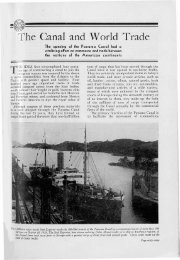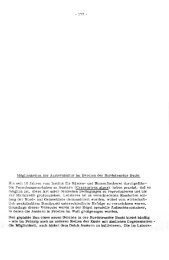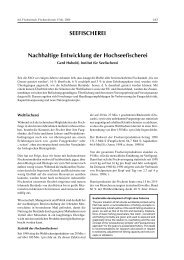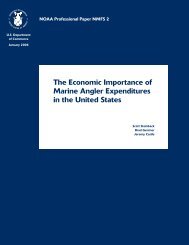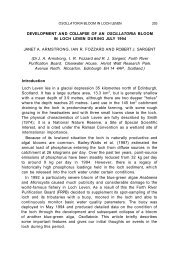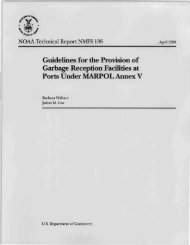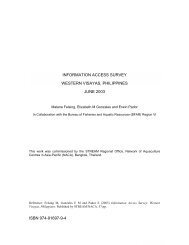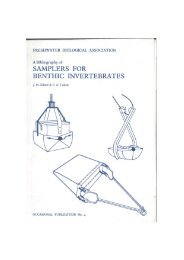Download - Aquatic Commons
Download - Aquatic Commons
Download - Aquatic Commons
Create successful ePaper yourself
Turn your PDF publications into a flip-book with our unique Google optimized e-Paper software.
Methods<br />
Checklist of Shallow-Water Marine Malacostracan<br />
Crustacea of Florida<br />
David K. Camp<br />
The list of benthic malacostracan Crustacea includes<br />
most of the described species known from Florida’s estuaries<br />
and nearshore coastal zone to depths of approximately<br />
37 meters, with exceptions noted below.<br />
Most of the list was compiled from previously published<br />
compendia, with taxonomic updates and additions<br />
taken from many widely scattered papers cited<br />
in the References section. Several species were added<br />
from lists of museum holdings, including those of the<br />
Florida Marine Research Institute Marine Specimen<br />
Collection.<br />
The list of Stomatopoda was taken principally from<br />
Manning (1969), Camp (1971), Manning and Camp<br />
(1981), and Camp and Manning (1982, 1986). Farrell<br />
(1979) produced an identification guide to Florida’s<br />
Mysidacea, and Stuck et al. (1979) published a key to<br />
mysidacean species of the northern Gulf of Mexico.<br />
The list of Amphipoda was begun several years ago<br />
by the late Douglas H. Farrell, who gave his list to me.<br />
A few amphipods originally on the list have not appeared<br />
in publications about Florida’s fauna, but were<br />
included by Dr. Farrell based on his observations of<br />
specimens from Florida. Dr. Farrell’s list was augmented<br />
with species from computer records of the<br />
cataloged holdings of the National Museum of Natural<br />
History, Smithsonian Institution; from lists of cataloged<br />
holdings of the Harbor Branch Oceanographic<br />
Institution Museum; from a list of species identified<br />
from shallow-water sites off Florida by Richard Heard<br />
and Sara LeCroy; and from published works cited<br />
below. Recently published compendia of Amphipoda<br />
include works of McCain (1968), Bousfield (1973), Myers<br />
(1981), Barnard and Barnard (1983), Barnard and Karaman<br />
(1991), Ortiz (1991),Thomas (1993), LeCroy (1995),<br />
Nelson (1995), and Lowry and Stoddart (1997). Many<br />
species described in several smaller papers by J. L.<br />
Barnard, James D.Thomas, and others were added.<br />
The list of Isopoda was derived mainly from<br />
Markham (1978, 1985), Kensley (1980), Menzies and<br />
Kruczynski (1983), Schultz and Johnson (1984), Kensley<br />
and Schotte (1985), and Kensley et al. (1995).<br />
The list of pelagic Euphausiacea was taken from<br />
Mikkelsen (1987). Although neither strictly benthic<br />
nor shallow-water organisms, euphausiaceans that<br />
come to the surface or into shallow water at night were<br />
included in this list because they may be captured by<br />
benthic sampling gear near shore on the east coast of<br />
Florida.<br />
The list of shallow-water Decapoda was extracted<br />
from the larger list of Florida’s decapods published by<br />
Abele and Kim (1986). A few species they inadvertently<br />
omitted plus additional, recently described<br />
species were added, and the taxonomic arrangement<br />
was updated.<br />
Lettered species (e.g.,“Genus name”sp. A) were included<br />
if they met two criteria: 1) the lettered designation<br />
was published in a peer-reviewed journal, and<br />
2) I was confident that voucher material exists and is<br />
retrievable. A few deeper-water species were included<br />
even though there is no published record of their occurrence<br />
from depths as shallow as 37 meters. These<br />
relatively rare species may be found in shallower waters<br />
in the future.<br />
Several taxa are not included in the list for various<br />
reasons.The following orders of marine malacostracan<br />
Crustacea are not treated here: Lophogastrida (cosmopolitan,<br />
oceanic, pelagic swimmers; about 40 species<br />
worldwide); Amphionidacea (monotypic: Amphionides<br />
reynaudii (H. Milne Edwards, 1833), oceanic, pelagic);<br />
and Mictacea (in the western Atlantic, known only<br />
from marine caves in Bermuda and the Guyana Basin)<br />
(Brusca and Brusca, 1990).The hyperiidean amphipods<br />
were not included because they are planktonic. I have<br />
not included the whale lice (Amphipoda: Cyamidae),<br />
although whales sometimes become stranded on<br />
Florida’s coasts. Finally, several shallow-water, benthic<br />
species that live near Florida and could be expected<br />
to occur here are not included in this list. Islandic<br />
species recently described from Cuba and the Bahama<br />
Islands may one day be found in Florida, especially in<br />
the Florida Keys. Shallow-continental-shelf species<br />
from nearby states, such as the mysidacean Pseudomma<br />
heardi Stuck, 1981, known from off Mississippi, or the<br />
pinnotherid crab Gemmotheres chamae (Roberts, 1975),<br />
known from off North Carolina, may also be found here<br />
in the future but are not listed.<br />
The classification of taxa follows that used in the<br />
most recently published works, with exceptions.Within<br />
the Amphipoda, a mixture of proposed classifications<br />
is used, and families are arranged alphabetically within<br />
suborders, as was suggested by the reviewers, because<br />
amphipod taxonomists have not reached a consensus<br />
about the higher classification of that group.<br />
FMRI Technical Report TR-3 123



